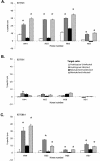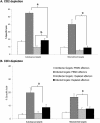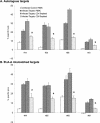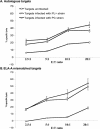Rhodococcus equi-infected macrophages are recognized and killed by CD8+ T lymphocytes in a major histocompatibility complex class I-unrestricted fashion
- PMID: 15557631
- PMCID: PMC529141
- DOI: 10.1128/IAI.72.12.7073-7083.2004
Rhodococcus equi-infected macrophages are recognized and killed by CD8+ T lymphocytes in a major histocompatibility complex class I-unrestricted fashion
Abstract
The goal of this research was to examine the role of cytotoxic T lymphocytes (CTL) in the control of Rhodococcus equi and specifically to determine if R. equi-specific CD8+ CTL occurred in the blood of immune horses. Equine peripheral blood mononuclear cells stimulated with antigen-presenting cells either infected with R. equi or exposed to soluble R. equi antigen lysed R. equi-infected target cells. Lysis was decreased to background by depletion of either CD2+ or CD3+ cells, indicating that the effector cell had a T-lymphocyte, but not NK cell, phenotype. Stimulation induced an increased percentage of CD8+ T cells in the effector population, and depletion of CD8+ T cells resulted in significantly decreased lysis of infected targets. Killing of R. equi-infected macrophages by effector cells was equally effective against autologous and equine leukocyte antigen A (classical major histocompatibility complex [MHC] class I) mismatched targets. To evaluate potential target antigens, target cells were infected with either virulent (80.6-kb plasmid-containing) or avirulent (plasmid-cured) R. equi. The degree of lysis was not altered by the presence of the plasmid, providing evidence that the virulence plasmid, which is required for survival within macrophages, was not necessary for recognition and killing of R. equi-infected cells. These data indicate that immunocompetent adult horses develop R. equi-specific CD8+ CTL, which may play a role in immunity to R. equi. The apparent lack of restriction via classical MHC class I molecules suggests a novel or nonclassical method of antigen processing and presentation, such as presentation by CD1 or other nonclassical MHC molecules.
Figures






Similar articles
-
Rhodococcus equi-specific cytotoxic T lymphocytes in immune horses and development in asymptomatic foals.Infect Immun. 2005 Apr;73(4):2083-93. doi: 10.1128/IAI.73.4.2083-2093.2005. Infect Immun. 2005. PMID: 15784549 Free PMC article.
-
The influence of age and Rhodococcus equi infection on CD1 expression by equine antigen presenting cells.Vet Immunol Immunopathol. 2009 Aug 15;130(3-4):197-209. doi: 10.1016/j.vetimm.2009.02.007. Epub 2009 Feb 14. Vet Immunol Immunopathol. 2009. PMID: 19285733
-
Clearance of virulent but not avirulent Rhodococcus equi from the lungs of adult horses is associated with intracytoplasmic gamma interferon production by CD4+ and CD8+ T lymphocytes.Clin Diagn Lab Immunol. 2003 Mar;10(2):208-15. doi: 10.1128/cdli.10.2.208-215.2003. Clin Diagn Lab Immunol. 2003. PMID: 12626444 Free PMC article.
-
Cellular mechanisms of lymphocyte-mediated lysis of tumor cells.Ann Ist Super Sanita. 1990;26(3-4):369-84. Ann Ist Super Sanita. 1990. PMID: 2151107 Review.
-
Molecular and infection biology of the horse pathogen Rhodococcus equi.FEMS Microbiol Rev. 2009 Sep;33(5):870-91. doi: 10.1111/j.1574-6976.2009.00181.x. Epub 2009 Apr 23. FEMS Microbiol Rev. 2009. PMID: 19453748 Review.
Cited by
-
Effects of Maternal Supplementation with Organic Trace Minerals including Zinc, Manganese, Copper, and Cobalt during the Late and Post-Partum Periods on the Health and Immune Status of Japanese Black Calves.Animals (Basel). 2023 Nov 28;13(23):3679. doi: 10.3390/ani13233679. Animals (Basel). 2023. PMID: 38067030 Free PMC article.
-
In vivo expression of and cell-mediated immune responses to the plasmid-encoded virulence-associated proteins of Rhodococcus equi in foals.Clin Vaccine Immunol. 2007 Apr;14(4):369-74. doi: 10.1128/CVI.00448-06. Epub 2007 Feb 14. Clin Vaccine Immunol. 2007. PMID: 17301216 Free PMC article.
-
The equine CD1 gene family is the largest and most diverse yet identified.Immunogenetics. 2014 Jan;66(1):33-42. doi: 10.1007/s00251-013-0741-6. Epub 2013 Nov 7. Immunogenetics. 2014. PMID: 24196432
-
Lymphocytes and macrophages are infected by Theileria equi, but T cells and B cells are not required to establish infection in vivo.PLoS One. 2013 Oct 7;8(10):e76996. doi: 10.1371/journal.pone.0076996. eCollection 2013. PLoS One. 2013. PMID: 24116194 Free PMC article.
-
Cloning and large-scale expansion of epitope-specific equine cytotoxic T lymphocytes using an anti-equine CD3 monoclonal antibody and human recombinant IL-2.Vet Immunol Immunopathol. 2007 Jul 15;118(1-2):121-8. doi: 10.1016/j.vetimm.2007.04.001. Epub 2007 Apr 8. Vet Immunol Immunopathol. 2007. PMID: 17498813 Free PMC article.
References
-
- Alvarez, B., C. Sanchez, R. Bullido, A. Marina, J. Lunney, F. Alonso, A. Ezquerra, and J. Dominguez. 2000. A porcine cell surface receptor identified by monoclonal antibodies to SWC3 is a member of the signal regulatory protein family and associates with protein-tyrosine phosphatase SHP-1. Tissue Antigens 55:342-351. - PubMed
-
- Batuwangala, T., D. Shepherd, S. D. Gadola, K. J. Gibson, N. R. Zaccai, A. R. Fersht, G. S. Besra, V. Cerundolo, and E. Y. Jones. 2004. The crystal structure of human CD1b with a bound bacterial glycolipid. J. Immunol. 172:2382-2388. - PubMed
-
- Beckman, E. M., S. A. Porcelli, C. T. Morita, S. M. Behar, S. T. Furlong, and M. B. Brenner. 1994. Recognition of a lipid antigen by CD1-restricted alpha beta+ T cells. Nature 372:691-694. - PubMed
-
- Brigl, M., and M. B. Brenner. 2004. CD1: antigen presentation and T cell function. Annu. Rev. Immunol. 22:817-890. - PubMed
Publication types
MeSH terms
Substances
Grants and funding
LinkOut - more resources
Full Text Sources
Research Materials

